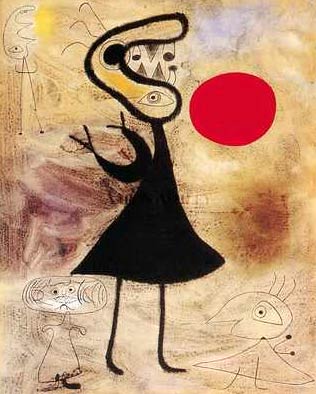
Woman in Front of The Sun

|
Joan Miro, a surrealist whose imagination had no limits, ranks among the most celebrated modern artists. Miro’s art is hard to describe. It is characterized by brilliant colors combined with simplified forms that remind us of drawings made by children at the age of five. Joan Miro’s art integrates elements of Catalan folk art. He liked to compare his visual arts to poetry. Woman in front of the Sun is an example of this artistic style.
Miro created this painting in 1950. It is characterized by the use of a few pure tones (namely black and red), big simple forms and exceptional laconism in combination with the energy of poetic expression. This painting has a childlike simplicity and playfulness to it. Miro sought essential pictorial vocabulary in primitive sources, particularly prehistoric cave paintings of his native Spain. He used signs and symbols, composed out of basic linear ingredients.
Miro once said: In my opinion, mastering freedom means mastering simplicity. Then, at most, a line, a color, is enough to make the picture. He was right, simplicity in form defines Woman in front of the Sun but there are many figurative meanings to the figures that appear in his painting that are unclear. A form (that we assume is a woman because of the title) appears to have a monster’s head and arms that are not formed. An eye is depicted in the middle of the head. There are also creatures that Miro drew in the three corners of the canvas. The colors used by Miro to create Woman in Front of the Sun were mostly primary colors, red and yellow but also with heavy use of black.
Later in Miro’s career, he changed his sign language. He retained many signs such as woman, bird, stars, eye, sun, etc.., but his style changed from being enigmatic and symbolic to simple and humorous. A figure now appears to be just a figure, no more.












